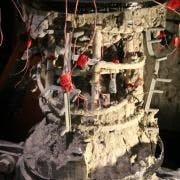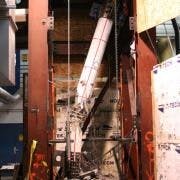Columns of strength
Concrete bridge structures are typically designed to last 50 to 75 years but seldom last half that time before rehabilitation is required due to degradation caused by corrosion of steel reinforcement.
Corrosion in commonly used epoxy-coated steel bars has raised both concerns regarding its use and interest in the use of alternative reinforcement such as fiber-reinforced polymer (FRP) bars. Glass FRP (GFRP) bars are a cost-competitive alternative to epoxy-coated steel bars and have certain advantages such as high tensile strength and very low susceptibility to corrosion.
Many transportation costs and user impacts associated with typical corrosion problems could be potentially eliminated with a proactive approach of using non-corrosive reinforcement (e.g. GFRP) in the original construction of concrete elements. This also is potentially a much more economical and less disruptive approach than the currently common reactive approach of retrofitting structures with external FRP jackets after degradation has occurred. There has been a considerable amount of research, testing and code-writing effort made towards the use of FRP bars in the construction of bridge deck and beam elements, but these efforts are still somewhat limited with regard to the use of FRP bars in construction of columnar elements.
Circular motion
Experimental tests were conducted recently at the University of Utah on circular concrete columns reinforced with GFRP and/or steel longitudinal bars and GFRP confining spirals to evaluate their behavior and viability as a potential construction alternative. The columns were tested with loads placed at varying eccentricities to observe the mode of failure, load capacity and general behavior associated with different geometric and slenderness conditions. One set of columns was reinforced with GFRP spirals and GFRP longitudinal bars (Type SG), another set of columns was reinforced with GFRP spirals and steel longitudinal bars (Type SS), and a final set of columns was reinforced with double GFRP spirals and a combination of GFRP and steel longitudinal bars (Type DB). The idea behind the double spiral is that the interior vertical steel bars are better protected from corrosion by the outer GFRP spirals and GFRP vertical bars, which increase the protective barrier to the vertical steel bars.
All columns were 12 in. in diameter with three being short (2.5 ft tall) and six being slender (12.25 ft tall). The tall columns met the criteria of being slender columns according to ACI 318-14 having a slenderness ratio kL/r of 49. The three short columns were tested under an axial load applied concentrically. Three of the slender columns were tested under an axial load applied at an eccentricity of 1 in., and the remaining three slender columns were tested under an axial load applied at an eccentricity of 4 in.
While concrete road and bridge structures are designed for a lifespan of 50-75 years, many do not make it even half as long, mostly due to degradation from within caused by pervasive corrosion of steel reinforcement.
The properties for the GFRP bars used in this research were tested by the manufacturer and found to have an ultimate tensile strength of 103,700 psi and a modulus of elasticity of 6.28 million psi. The properties of the steel bars had a yield strength of 64,000 psi and a modulus of elasticity of 29 million psi. The concrete used in this research was high strength and had a compressive strength of 13,000 psi at the time of testing.
Short and slender
The three short columns tested under concentric axial compressive load are identified as #1S-DB0 (both steel and GFRP longitudinal bars with double spirals), #2S-SS0 (steel longitudinal bars) and #3S-SG0 (GFRP longitudinal bars). These columns achieved maximum loads of 1,376 kips (#1S-DB0), 1,498 kips (#2S-SS0) and 1,602 kips (#3S-SG0). Column-failure modes included compressive rupture of the longitudinal GFRP bars, tensile rupture of the GFRP spiral, and compressive buckling of the longitudinal steel bars.
The three slender columns tested with a 1-in. eccentric axial compressive load are identified as #4T-DB1 (both steel and GFRP longitudinal bars), #5T-SS1 (steel longitudinal bars) and #6T-SG1 (GFRP longitudinal bars). These columns achieved maximum loads of 925 kips (#4T-DB1), 850 kips (#5T-SS1) and 861 kips (#6T-SG1) and maximum mid-height horizontal deflections of 0.28 in. (#4T-DB1), 0.35 in. (#5T-SS1) and 0.24 in. (#6T-SG1). All three columns experienced sudden material failures near the middle half of the column with failure modes including compressive rupture of the longitudinal GFRP bars, tensile rupture of the GFRP spiral and compressive buckling of the longitudinal steel bars.
GFRP reinforcement used
in column tests during the study.
Short column #1S-DB0
tested to failure (concentric load).
Slender column #5T-SS1
tested to failure (1-in. eccentricity).
Slender column #9T-SG4
tested to failure (4-in. eccentricity).
The three slender columns tested with a 4-in. eccentric axial compressive load are identified as #7T-DB4 (both steel and GFRP longitudinal bars), #8T-SS4 (steel longitudinal bars) and #9T-SG4 (GFRP longitudinal bars). These columns achieved maximum loads of 213 kips (#7T-DB4), 206 kips (#8T-SS4) and 150 kips (#9T-SG4), and maximum mid-height horizontal deflections of 2.5 in. (#7T-DB4), 2.24 in. (#8T-SS4) and 2.82 in. (#9T-SG4). All three columns experienced stability-type, buckling failures due to the large eccentricity with the concrete cover on the compressive side breaking away near the middle half of the column. There was much less damage to the reinforcement as compared to the other tests due to the fact that this was a stability failure. It was interesting to note that once the load was removed the all-GFRP column (#9T-SG4) rebounded almost entirely to the vertical position due to the non-yielding, elastic nature of the GFRP longitudinal bars as opposed to the yielding nature of the steel longitudinal bars.
Proper reinforcement
An analytical confinement and buckling model also was developed and validated against these tests to provide a means to predict the behavior and capacity of FRP-reinforced concrete columns. The modeled results, in general, were found to be in good agreement with the experimental results. Use of these models enabled the analysis of additional reinforcement scenarios utilizing FRP (glass or carbon) longitudinal bars and spirals.
In general it was found that FRP spirals and FRP longitudinal bars can be a viable method of reinforcement for concrete columns, particularly in corrosive environments. FRP spirals, however, need to be placed at a closer pitch spacing to provide confinement levels similar to steel spirals due to the lower modulus of elasticity of FRP composites. On the other hand, FRP longitudinal bars can provide increased deflection capacity as compared with steel bars due to the higher tensile capacity of FRP composites. It also was observed that the influence of confining pressure of the spirals is less pronounced in high-strength concrete than it is with normal-strength concrete.
Additional points of interest observed through the experimental testing and analytical modeling developed in this research are as follows. Slender columns with steel longitudinal bars are able to achieve larger axial load capacities over those with only GFRP longitudinal bars because of the higher compressive strength contribution provided by the steel bars. This was found in both the analytical models as well as the experiments where the columns with a 4-in. eccentricity having steel longitudinal bars achieved at least a 37% increase in axial load over the columns having only GFRP longitudinal bars. Slender columns with GFRP longitudinal bars are able to achieve larger lateral deflection capacities over those with only steel longitudinal bars because of the higher tensile strength capacity provided by the GFRP bars. This was found in both the analytical models as well as the experiments for columns with 4-in. eccentricity where a 12% minimum increase in lateral deflection was obtained for columns having GFRP longitudinal bars as opposed to columns having only steel longitudinal bars. These columns also are able to better maintain the axial load capacity once the lateral deflection continues beyond the peak load obtained due to the ability of the GFRP bars to contribute an increase in tensile strength with the increased moment-curvature demand from the larger deflection as opposed to steel where its tensile strength is limited to the maximum yield strength.
Additional research is needed to better quantify the confining capacity of FRP spirals and required pitch for design. Research investigating the behavior of FRP-reinforced concrete columns under seismic loading also is an important consideration for future research. R&B
Acknowledgment: The authors acknowledge the contribution of materials by Hughes Brothers Inc. and Hanson Structural Precast.







